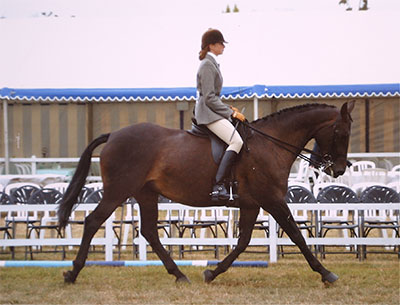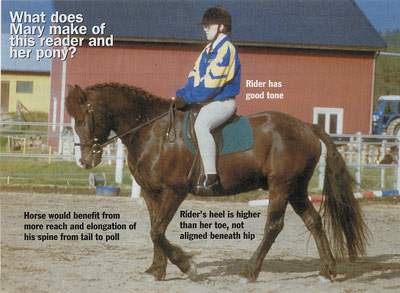RWYM
ARTICLE 37
 The photograph shows a 12 year old girl riding her Section D Welsh pony mare in a showing class. Her mother tells me that they bought the pony at a Welsh auction as a three year old, and backed her themselves. She adds, ‘Storm works well at home but at shows she gets very tense…her show always looks rushed, and this is the comment the judges always give…we think that if she worked as well at shows as she does at home, she could make first place at good shows’.
The photograph shows a 12 year old girl riding her Section D Welsh pony mare in a showing class. Her mother tells me that they bought the pony at a Welsh auction as a three year old, and backed her themselves. She adds, ‘Storm works well at home but at shows she gets very tense…her show always looks rushed, and this is the comment the judges always give…we think that if she worked as well at shows as she does at home, she could make first place at good shows’.
What a lovely picture of a well-ridden pony. Storm is tracking up well in trot, and the angle of the cannon bone on the hind limb matches the angle of the upper part of the forelimb. This tells us that the hind leg is being bought well underneath the body – she is pushing herself along with her hind legs instead of pulling herself along with her forelegs. She is reaching nicely into the rein, with her nose well in front of vertical, and the poll as the highest point of her neck (although the flying mane stops this from being your first impression).
However, the pony could be more ‘in front of’ Sam. If you draw two circles in your mind, one from the rider back, encompassing the horse’s loins, quarters and hind legs, and one from the rider forward, encompassing the horse’s shoulders, neck and head, there is more horse in the back circle than there is in the front one. Although the pony may actually have a long back, more skilful riding would change this look, elongating her neck to equalise the circles.
If Storm were truly ‘in front of’ Sam, I think that much of her show-related tension would disappear, and this is the challenge that faces Sam as her rider. Notice how the pony is holding her upper lip. This is the sign of a stressed horse, and the phrase ‘stiff upper lip’ has more truth to it than you might imagine. For state of the upper lip (in both horses and people) tells us what is happening in the limbic system, which is the seat of the emotions. I well believe that this pony takes hot and sensitive (as most Welsh ponies are) to the edge of being emotionally delicate, and if she acts like a tank at shows, her apparent ignorance is a cover-up for her delicate nature.
Sam is doing a tremendous amount right, and has a lot going for her as a rider. Notice the angle of her thigh, which lies, as it should, at about 45 degrees to the ground. However, we could criticise her lower leg position, as her calf is vertical and she would not land on her feet on the grass if her pony were taken out from under her by magic. Her straight vertical line from ear to shoulder to hip brushes the back of her heel instead of extending down to her ankle bone. (I’m sure that this is the showing world’s interpretation of that shoulder/hip/heel line.) But none the less there is a very strong sense of her body being ‘all of a piece’: She fits so well on this pony, and is not making many of the most common and killing mistakes.
There is a very good straight line from her elbow to her wrist to the pony’s mouth, although her wrists appear to be slightly rounded The line of her back is very good, and her upper body has a martial arts type stance, complete with her seat bones pointing down, her ribs down towards her hips, and her stomach muscles bearing down. Only about 3% of riders organise themselves as well as this (and a remarkable number of good adult riders started their competition career in showing, which at least encourages them to develop good riding skills). This is an enviable start, and I hope she will take her skills beyond the world of showing into eventing or dressage, where she could have potential to get herself talent spotted, and to do really well.
Let’s give you some contrasts so that you realise the differences between what you might be doing and what Sam is doing. Sit on a hard chair on your hands, with your palms facing down. Your seat bones should be pretty (if not painfully) obvious to you. Arrange your pelvis and spine so that they are pointing straight down. Then slouch by dropping your chest and rounding your back, and realise that this makes your seat bones point forward. Pass through ‘down’ again on your way to hollowing your back, which points your seat bones backwards. Now grow as tall as you can. Your seat bones point even more back, your stomach sucks in, your back hollows, your chest lifts, and your breathing practically stops!
Sam is not growing tall in this way. Neither is she slouched. That martial arts stance keeps her seat bones pointing down, and anyone who habitually either hollows or rounds her back would feel very strange if I rearranged her into the position Sam is using here. But even if it feels wrong to you, can you see that it looks right on Sam? Check yourself out more rigorously by placing your chair sideways on to a large mirror. Then you can turn your head to check that your are not leaning forward or back, and to check that the line of your back shows minimal curves.
Sam’s rightness is enhanced by the use of her stomach muscles, and this adds the power that enables her to look as if she is cruising along on this horse doing nothing.
With your seat bones pointing down and your feet flat on the floor, put one hand under your sternum, and put the thumb and first finger of the other hand each side of your spine at waistband level. Then clear your throat. You should feel your muscles push out against your hands. Put your hands on your sides and repeat the experiment. Then place the fingers of one hand half way between your belly button and your pubic bone, and clear your throat again.
Sam is riding as if she is doing this permanently. I first called this use of your abdominal muscles ‘bearing down’, although I now think that ‘bear out’ might have been a better term, since it does not make you sit heavier. Wherever you have soft tissue, i.e. in the entire band around your waist between your ribs and your hips, and all down your abdominal muscles from your sternum to your pubic bone, your guts push against your skin. Think of pulling your stomach in, making the muscles into a wall, and then pushing against that wall. It is as if your torso were a jam jar or a baked bean tin, and the contents of the tin are under pressure, pushing against the edges, but without deforming the shape of the container.
The next difficulty arises with the need to breathe and bear down both at the same time. This requires diaphragmatic breathing, which will be familiar to you if you have learnt to sing or play a wind instrument. In this, the ribs expand outwards but do not lift up: think of the air being drawn down into your abdomen, as if pair of bellows down there was sucking the air in.
Bearing down whilst breathing well is a big deal for most riders – I suggest that people practice whilst driving their car, for this has to become a way of life. Sam is one of the very few people to discover this so young that she has already ingrained it as a correct pattern in her body. To her it probably feels perfectly normal, as if she is doing nothing – but her version of ‘nothing’ would be very different from most other people’s ‘nothing’ (and after another ten years of practicing riding well, her ‘nothing’ will make her a phenomenally powerful rider).
I would enjoy the chance to help Sam build on the tremendous start she has made, so that she learns how to recognise and create the feels which define ‘right’. This will give her progressively more influence over her horses, and make her into an effective, sensitive rider with tremendous feel. Basically, there are two types of good riders. The fist type can disguise problems in the horse, and make it look as if they are having an easy ride when they are actually contending with all sorts of difficulties. The second type develops the tools to solve those problems and to influence the horse for the better. The first group make good auction and competition riders, but do not train horses well. The second group train horses with great skill and sensitivity. I hope Sam will become one of these.












